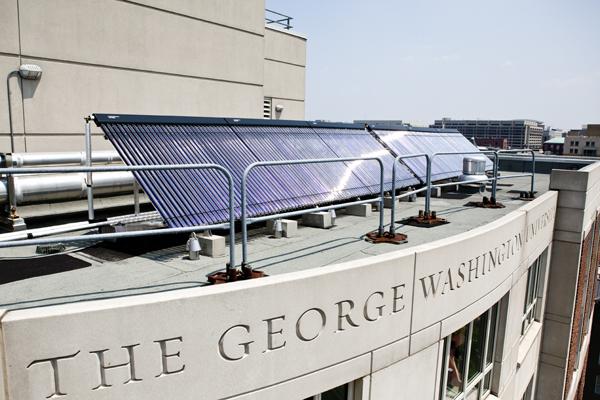GW is installing its fourth system to heat water using solar energy in a residence hall this year.
Officials hope the solar thermal panels will start functioning in the upperclassman residence hall The Dakota by next summer, said Mark Ellis, sustainability project facilitator. The system is the latest step in GW’s push to reduce its carbon and fossil fuel footprint and falls in line with the its goal to cut carbon emissions 40 percent by 2025.
Three other buildings on campus – Shenkman Hall, Building JJ and 1959 E St. – already have similar systems in place, Ellis said.
University spokesman Kurtis Hiatt declined to comment on whether similar systems would be installed in more residence halls in the future. He did not provide specific details about how much energy the system would save.

To save energy, the University is also looking long term: GW partnered with American University and Duke Energy Renewables this summer, agreeing to derive half of their power from solar energy over the next two decades. University President Steven Knapp spoke about that partnership at a climate conference in Boston last week, touting GW as a model of sustainability for other universities.
Peter LaPuma, an associate professor in the Milken Institute School of Public Health’s department of environmental and occupational health, said solar thermal panel systems save schools money by cutting down on the costs to heat water with gas.
“It’s efficient enough to where you can literally be taking a shower the next day with the sun from the day before. It’s a really good system that often pays for itself,” he said.
Ellis said GW, along with the solar development company Nextility, will measure The Dakota’s roof and study water usage in the building to determine the size of the system.
The new system will save the University money because GW will pay Nextility less than what it would pay to heat water with natural gas, Ellis said.
In last year’s eco-challenge – a signature of Knapp’s sustainability strategy that encourages students to think greener – electricity use in The Dakota decreased 4 percent. Meanwhile, water use increased nearly 60 percent from the previous year. Twelve other residence halls also saw increases last year.
Colleges are increasingly adding solar power capability to their campuses, especially when building new residence halls, said Jane Davidson, a renewable energy professor at the University of Minnesota. She said solar energy can be about 35 percent more efficient when heating water.
“Certainly energy management, conservation and using renewable sources of energy are an important part of any campus because they consume so much energy. You’re seeing a trend when new buildings go up,” said Davidson, who is the director of the University of Minnesota’s solar energy laboratory.
Several sites on campus, like the Milken Institute School of Public Health, have roofs topped with several inches of grass to cut heating and cooling costs.
Two years ago, officials crafted the University’s decade-long sustainability goals, including steps like adding green space to campus and eventually becoming a zero-waste school through composting and recycling.
Several of GW’s peer schools – including Duke, Emory, Georgetown and Northwestern universities – utilize solar energy on their campuses, according to the Association for the Advancement of Sustainability in Higher Education’s database.
Christopher O’Brien, the director of sustainability at American University, said colleges have embraced solar energy over the last few years as the costs of installing solar panels have decreased while popularity grows. O’Brien said the costs for specific projects can vary depending on the number of panels and the amount of energy harnessed.
“You’ve got a sector as a whole that’s paying attention to the issue of climate change and you’ve got a technology that has hit a price point that makes it a solution that is carbon neutral and cost competitive,” O’Brien said.







